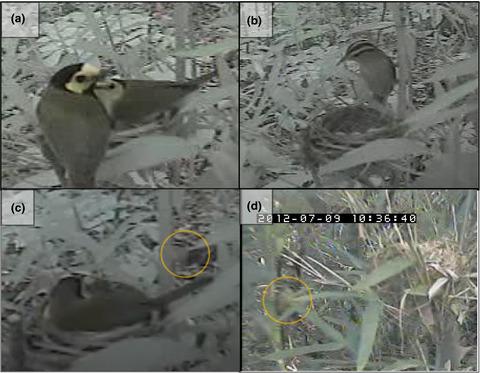当前位置:
X-MOL 学术
›
Ecol. Evol.
›
论文详情
Our official English website, www.x-mol.net, welcomes your
feedback! (Note: you will need to create a separate account there.)
Evidence of nest material kleptoparasitism in Worm-eating Warblers (Helmitheros vermivorum) in east-central Arkansas, USA
Ecology and Evolution ( IF 2.3 ) Pub Date : 2021-04-09 , DOI: 10.1002/ece3.7339 Amy L Wynia 1 , James C Bednarz 1
Ecology and Evolution ( IF 2.3 ) Pub Date : 2021-04-09 , DOI: 10.1002/ece3.7339 Amy L Wynia 1 , James C Bednarz 1
Affiliation

|
Nest material kleptoparasitism likely evolved in birds to reduce the cost of searching for and collecting material themselves. Although nest material kleptoparasitism has been reported commonly in colonially nesting species, reports for solitary breeding species are infrequent, especially for neotropical migratory species. Here, we report potential and actual nest material kleptoparasitism in the Worm-eating Warbler (Helmitheros vermivorum). We deployed video camera systems at passerine nests (n = 81) in east-central Arkansas during summers 2011–2012. In one video, we observed a Worm-eating Warbler stealing nesting material from a Hooded Warbler (Setophaga citrina) nest. One day later, we later observed a Worm-eating Warbler landing within 0.5 m of the same warbler nest when the female was incubating, which possibly deterred a second theft of nesting material. In a third video recording, we observed another Worm-eating Warbler landing within 1 m of an Indigo Bunting (Passerina cyanea) nest. As far as we could determine, neither of these latter two nest visits resulted in nest material kleptoparasitism. Potential benefits of nest material kleptoparasitism include reduced competition for limited nest materials, easy access to suitable material, reduced travel distance, and reduction of nest predation risk; however, costs include risk of attack by host or introducing parasites to one's nest. Importantly, this behavior could ultimately affect the behavioral and life history evolution of a species. We suggest further work should be conducted to determine the prevalence of nest material kleptoparasitism in Worm-eating Warblers and other solitary breeding passerines, including efforts to quantify the benefits and costs of this behavior.
中文翻译:

美国阿肯色州中东部食虫莺 (Helmitheros vermivorum) 巢穴材料盗寄生的证据
巢穴材料盗窃寄生可能是在鸟类中进化出来的,以减少自己寻找和收集材料的成本。尽管在群居筑巢物种中常见巢穴材料盗窃寄生现象,但有关单独繁殖物种的报道却很少,特别是对于新热带迁徙物种。在这里,我们报告了食虫莺( Helmitheros vermivorum )中潜在和实际的巢穴材料盗窃寄生现象。 2011 年至 2012 年夏季,我们在阿肯色州中东部的雀形目鸟类巢穴 ( n = 81) 部署了摄像机系统。在一段视频中,我们观察到一只食虫莺从冠莺 ( Setophaga citrina ) 巢中窃取筑巢材料。一天后,我们观察到一只食虫莺在雌性孵化时降落在距同一个莺巢 0.5 m 的范围内,这可能阻止了第二次筑巢材料被盗的情况。在第三个视频记录中,我们观察到另一只食虫莺降落在靛鹀 ( Passerinayanea ) 巢穴 1 m 范围内。据我们所知,后两次巢穴访问都没有导致巢穴材料盗窃寄生。巢穴材料盗贼寄生的潜在好处包括减少对有限巢穴材料的竞争、容易获得合适的材料、减少行进距离以及降低巢穴被捕食风险;然而,成本包括被宿主攻击或将寄生虫引入巢穴的风险。重要的是,这种行为最终可能会影响一个物种的行为和生活史进化。 我们建议应开展进一步的工作,以确定食虫莺和其他单独繁殖的雀形目鸟类中巢材盗窃寄生的流行情况,包括努力量化这种行为的收益和成本。
更新日期:2021-05-19
中文翻译:

美国阿肯色州中东部食虫莺 (Helmitheros vermivorum) 巢穴材料盗寄生的证据
巢穴材料盗窃寄生可能是在鸟类中进化出来的,以减少自己寻找和收集材料的成本。尽管在群居筑巢物种中常见巢穴材料盗窃寄生现象,但有关单独繁殖物种的报道却很少,特别是对于新热带迁徙物种。在这里,我们报告了食虫莺( Helmitheros vermivorum )中潜在和实际的巢穴材料盗窃寄生现象。 2011 年至 2012 年夏季,我们在阿肯色州中东部的雀形目鸟类巢穴 ( n = 81) 部署了摄像机系统。在一段视频中,我们观察到一只食虫莺从冠莺 ( Setophaga citrina ) 巢中窃取筑巢材料。一天后,我们观察到一只食虫莺在雌性孵化时降落在距同一个莺巢 0.5 m 的范围内,这可能阻止了第二次筑巢材料被盗的情况。在第三个视频记录中,我们观察到另一只食虫莺降落在靛鹀 ( Passerinayanea ) 巢穴 1 m 范围内。据我们所知,后两次巢穴访问都没有导致巢穴材料盗窃寄生。巢穴材料盗贼寄生的潜在好处包括减少对有限巢穴材料的竞争、容易获得合适的材料、减少行进距离以及降低巢穴被捕食风险;然而,成本包括被宿主攻击或将寄生虫引入巢穴的风险。重要的是,这种行为最终可能会影响一个物种的行为和生活史进化。 我们建议应开展进一步的工作,以确定食虫莺和其他单独繁殖的雀形目鸟类中巢材盗窃寄生的流行情况,包括努力量化这种行为的收益和成本。











































 京公网安备 11010802027423号
京公网安备 11010802027423号